Stephen Morris's Blog, page 49
February 17, 2014
Violet, the flower of February

Violets were used in magic to heal, protect, and pacify both mortals and spirits.
Violets, the flower of February, were considered sacred to the god Ares and to Io, and possibly Apollo because it appeared in an ancient Near Eastern myth that probably inspired the Greek and Roman myth of Venus and Adonis. According to this story, the great mother goddess Cybele loved Attis, who was killed while hunting a wild boar. Where his blood fell on the ground, violets grew.
Other Greek myths tell us that violets first sprang where Orpheus laid his enchanted lute and that the goddess Persephone and her companion Nymphs were gathering rose, crocus, violet, iris, lily and larkspur blooms in a springtime meadow when she was abducted by the god Hades. Another tale recounts how Venus had been arguing with her son Cupid, as to which was more beautiful… herself or a nearby group of girls, and Cupid, with no fear of his mother, declared for the girls. This sent Venus into such a rage that she beat her rivals till they turned blue and became violets.
Also, the Greek word for violet is “io.” Io is a character in Greek mythology and the daughter of King Argos, whom Zeus loved. However, Zeus was concerned that Hera would discover their affair, so he turned Io into a cow and then created the sweet-scented flowers that we now know as violets for her to eat.
Later, in Christian symbolism, the violet stood for the virtue of humility, or humble modesty, and several legends tell of violets springing up on the graves of virgins and saints. European folktales associate violets with death and mourning. The flowers were also used in magical healing and protection.
February 13, 2014
Can You Imagine It?!?!

This afternoon I checked the WordPress 2013 Annual Report for my site here. I was flabbergasted! Here’s the opening paragraph of the report:
“The concert hall at the Sydney Opera House holds 2,700 people. This blog was viewed about 14,000 times in 2013. If it were a concert at Sydney Opera House, it would take about 5 sold-out performances for that many people to see it.
In 2013, there were 97 new posts, not bad for the first year!
The busiest day of the year was March 19th with 132 views. The most popular post that day was Spring has Sprung!.”
WHO WOULD ATHUNK IT?!?
February 9, 2014
Aquarius (January 20 — February 18)
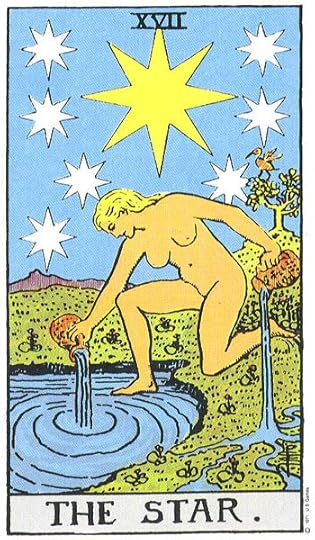
Aquarius is associated with the tarot card The Star, often interpreted in terms of generosity, hope, inspiration, and serenity.
Aquarius was known to the Babylonian astrologers who associated the constellation with the god Ea, who is commonly depicted holding an overflowing vase. Aquarius was also associated with the destructive floods that the Babylonians regularly experienced, and thus was negatively connoted. In Ancient Egypt, Aquarius was associated with the annual flood of the Nile; the banks were said to flood when Aquarius put his jar into the river, beginning spring.
In the Greek tradition, the constellation became represented as simply a single vase from which a stream poured down to Piscis Austrinus.
In Greek mythology, Aquarius is sometimes associated with Deucalion, the son of Prometheus who built a ship with his wife Pyrrha to survive an imminent flood. They sailed for nine days before washing ashore on Mount Parnassus. Aquarius is also sometimes identified with beautiful Ganymede, a youth in Greek mythology and the son of Trojan king Tros, who was taken to Mount Olympus by Zeus to act as cup-carrier to the gods. Neighboring Aquila represents the eagle, under Zeus’ command, that snatched the young boy; some versions of the myth indicate that the eagle was in fact Zeus transformed. An alternative version of the tale recounts Ganymede’s kidnapping by the goddess of the dawn, Eos, motivated by her affection for young men; Zeus then stole him from Eos and employed him as cup-bearer. Yet another figure associated with the water bearer is Cecrops I, a king of Athens who sacrificed water instead of wine to the gods.
February 6, 2014
The Dresden Files
The Dresden Files series was my introduction to all that urban fantasy is and can be. These books remain the granddaddy of all urban fantasy, as far as I am concerned, the brilliance of which others can only aspire to reach. The way Jim Butcher researches and then reshapes Celtic myth so that it becomes the basis of Harry Dresden’s world is stunning. His thoughtful descriptions of how magic “works” is well-developed and coherent; the discussion in Ghost Story (the 13th book of the series) of how ghosts or other non-physical agents are able to interact with the physical world–both influencing it and being influenced by it themselves–is logical, easy to follow, and provokes the “Why, of course!” moment that all good writing hopes to achieve.
Although it is recommended to read the books in order, I must admit that I did not do so when I first discovered the series and each books works well as a stand-alone novel. Each character is introduced again as necessary and the reader is not left wondering “Who is that” What are they talking about? Why did they do that?”
Hurry to start your adventures with Harry Dresden ASAP!
January 31, 2014
Candlemas
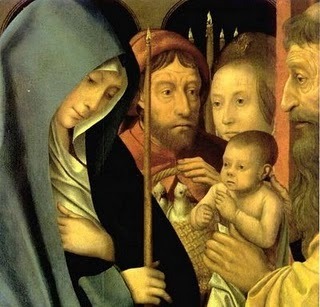
Marking the 40th day after Christmas, Candlemas celebrates the triumph of light/spring over darkness/winter. Candles blessed on this day were among the most powerful talismans available to ordinary folk in the Middle Ages.
Marking the 40th day after Christmas, Candlemas celebrates the triumph of light/spring over darkness/winter. Candles blessed on this day were among the most powerful talismans available to ordinary folk in the Middle Ages.
Candlemas, the name taken from the custom of blessing the year’s supply of candles on this day, is the 40th day after Christmas and marks the day Jesus was brought into the Temple by the Mother of God and acclaimed by the elder Simeon as “the light of revelation to the Gentiles and the glory of … Israel.” He also told the Mother of God that a sword would pierce her own heart during the ministry of her Son.
Candlemas, attached to the older feast of Imbolc and the quarter-day between Winter Solstice and Vernal Equinox and thus marking the first day of spring, was even more popular than Christmas in many areas (such as those under the influence of Byzantium and Byzantine Christian culture). People would flock to the churches to obtain the candles blessed on this day as the power of these candles to dispel darkness, death, illness, demons, and nearly anything else that might be considered dangerous to humans was widely reputed to make them the most powerful weapons in the medieval arsenal against evil.
It was also common in western Europe for new archbishops or other leading churchmen to receive their pallium (the “stole,” a vestment similar to a scarf that drapes around the shoulders) on this day, woven from wool sheared from lambs on St. Agnes’ day (January 21).
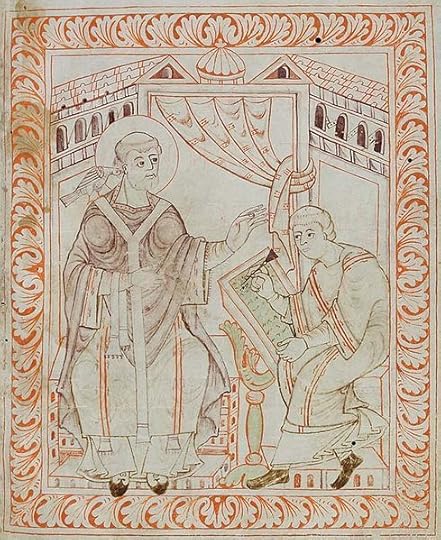
10th century illumination of St. Gregory the Great wearing his pallium.
January 28, 2014
Imbolc: The first day of Spring

Snowdrops at a creek announce Imbolc. The first blooms of snowdrops or blackthorns or the first birth of the new lambs were often considered the announcement of Imbolc’s arrival. (photo by Tony Eaglehart)

Blackthorn blooming at Imbolc.
The Celtic — and magical! — festival of Imbolc, celebrated February 1-2, was considered the first day of spring in Celtic cultures and across Europe in general during the medieval period. Although we nowdays generally consider the soltice or equinox the first day of a season (December 21 as the first day of winter, March 21 as the first day of spring, June 21 as the first day of summer, and September 21 as the beginning of autumn), those days were previously considered the mid-seasons. (That is why we can sing Christmas carols about “midwinter” in December and have Midsummer night dreams in June!) The traditional changes of the seasons were the “quarter days” which marked the midpoints between the mid-seasons. So we get the Celtic/magical festivals of Samhain (October 31, the first day of winter), Imbolc (February 1-2, the beginning of spring), Beltane (May, the first day of summer), and Lammas (August 1, the beginning of autumn).
Because Imbolc is the beginning of spring, it is often associated with various means of predictng the coming weather which is so crucial during the planting season of agricultural societies. Hence, we consult the groundhog to determine if he sees his shadow or not in order to know if cold and snow will last another six weeks or not. In Serbia, a bear who wakes from his hibernation to stumble out of his cave and see his shadow will know whether to go back to sleep for another six weeks or not, based on whether he sees his shadow.Imbolc was believed to be when the Cailleach—the divine hag of Gaelic tradition—gathers her firewood for the rest of the winter. Legend has it that if she wishes to make the winter last a good while longer, she will make sure the weather on Imbolc is bright and sunny, so she can gather plenty of firewood. Therefore, people would be relieved if Imbolc is a day of foul weather, as it means the Cailleach is asleep and winter is almost over. At Imbolc on the Isle of Man, where she is known as Caillagh ny Groamagh, the Cailleach is said to take the form of a gigantic bird carrying sticks in her beak.
January 23, 2014
Jonathan Strange and Mr. Norrell
This first novel by Susanna Clarke, Jonathan Strange and Mr. Norrell, is an intriguing exploration of the alternate history of magic’s restoration to England during the war against Napoleon. Mr.. Norrell, an unlikeable old man who dares to make the jump from theoretical magic to practical magic(!), struggles to keep magic in England completely under his control but is forced by circumstance to take on Jonathan Strange as a student. Strange’s attitude toward magic is much more open and welcoming, eager to make magic available to the English public. Lurking in the background is a malignant fairy king, to whom Norrell owes a terrible debt. There a several storylines going on in the novel that weave together and overlap while each maintaining its own integrity as a subsidiary tale. When Clarke brings them all together at the novel’s climax, the effect is stunning.
A lengthy but delightful romp through the possible alternative history of the United Kingdom, I urge everyone interested in bringing magic back into the modern world to read the record of Strange and Norrell.
January 19, 2014
Carnation, the birth flower of January

Carnations were given to the gods by the Romans and later used to provoke love in the hearts of those who received them.
Composed of tightly packed, fringed petals of white, yellow, pink, or red, carnations have many different meanings. To the Indians of Mexico, they are the “flowers of the dead,” and their fragrant blooms are piled around corpses being prepared for burial. (Perhaps because carnations are poisonous and should never be eaten!) For the Koreans, three carnations placed on top of the head are a form of divination. The flower that withers first indicates which phase of the person’s life will contain suffering and hardship. To the Flemish people of Europe, red carnations symbolized love, and a kind of carnation called a pink was traditionally associated with weddings. Red carnations were also used to provoke love and admiration in the recipient for the giver and to overcome heartache.
Also known as Jove’s flower, white carnations were used by the ancient Romans to pay tribute to the gods they love. Wreaths of white carnations mixed in with other colors of carnations are laid in front of the statues of Roman gods.
Associated with the element of fire and the sun, carnations were also used in England during the reign of Queen Elizabeth I to prevent death (execution) on a scaffold and can still be used in protective magic.
January 13, 2014
Capricorn (21 December-20 January)
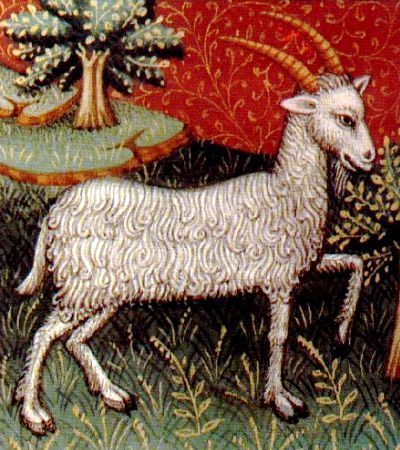
This illustration of Capricorn is from a 15th century astrological handbook.
Despite its faintness, Capricornus has one of the oldest mythological associations, having been consistently represented as a hybrid of a goat and a fish since the Middle Bronze Age. First attested in depictions on a cylinder-seal from around the 21st century BC, it was explicitly recorded in the Babylonian star catalogues as “The Goat-Fish” before 1000 BC. The constellation was a symbol of the god Ea and in the Early Bronze Age marked the winter solstice.
In Greek mythology, the constellation is sometimes identified as Amalthea, the goat that suckled the infant Zeus after his mother Rhea saved him from being devoured by his father Cronos (in Greek mythology). The goat’s broken horn was transformed into the cornucopia or horn of plenty.Capricornus is also sometimes identified as Pan, the god with a goat’s head, who saved himself from the monster Typhon by giving himself a fish’s tail and diving into a river.
People born under this Sign are sensitive, sensible and secure in their own space. They not take mindless decisions but at the same time they will take well-calculated risks to get what they want. However, there are some minuses as well. Let’s have a look at some of the usual positive and negative traits of the Capricorn-born.
Known for their pragmatic approach, the Capricorn apply their minds and take into account all the facts before going forward. These confident individuals aim high and do their best to reach their goals. Their ambitious nature can be attributed to their need to build a secure future for themselves and their families. They are wise, sensible and rarely over-the-top. People trust their sound judgment and often come to them seeking their valuable advice. Once they set their eyes on something, they will start their journey to get it. They have all the patience and discipline in the world to get where they want to but they will not take pointless risks.
However, the Capricorn-born can also be pessimistic as they lack the confidence to go against the odds. No matter where they reach in life, on the back of their minds they will see themselves as under-achievers, although they are stubborn will stick to their opinions. Good at communicating but basically shy, they will take their own sweet time to open up. The Capricorn are very concerned about how turn of events will affect them, and therefore, they tend to be quite self-centered. The Capricorn also often come across at detached individuals who will not get close to people beyond a certain point. Emotional involvement doesn’t come easily to them. Mood swings sometimes make them behave irresponsibly and ruin things.
January 9, 2014
12th Night, Part 2
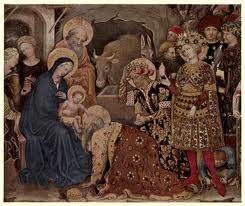
The arrival of the 3 kings to worship the newborn Christ-child is celebrated on Twelfth Night.
Twelfth Night is a festival marking the coming of the Epiphany and concluding the Twelve Days of Christmas.
In medieval and Tudor England, the Twelfth Night marked the end of a winter festival that started on All Hallows Eve — now more commonly known as Hallowe’en. The Lord of Misrule symbolizes the world turning upside down. On this day the King and all those who were high would become the peasants and vice versa. At the beginning of the Twelfth Night festival, a cake that contained a bean was eaten. The person who found the bean would rule the feast. Midnight signaled the end of his rule and the world would return to normal. The common theme was that the normal order of things was reversed. This Lord of Misrule tradition dates back to pre-Christian European festivals such the Ancient Roman festival of Saturnalia.
(Shakespeare’s play Twelfth Night, or What You Will was written to be performed as a Twelfth Night entertainment. The play has many elements of the Lord of Misrule theme, in the tradition of Twelfth Night, such as a woman Viola dressing as a man, and a servant Malvolio imagining that he can become a nobleman.)
Food and drink are the center of the celebrations in modern times, and all of the most traditional ones go back many centuries. The punch called wassail is consumed especially on Twelfth Night, but throughout Christmas time, especially in the UK. Around the world, special pastries, such as the tortell and king cake are baked on Twelfth Night, and eaten the following day for the Feast of the Epiphany celebrations. In English and French custom, the Twelfth-cake was baked to contain a bean and a pea, so that those who received the slices containing them should be designated king and queen of the night’s festivities.
In colonial America, a Christmas wreath was always left up on the front door of each home, and when taken down at the end of the Twelve Days of Christmas, any edible portions would be consumed with the other foods of the feast. The same held true in the 19th-20th centuries with fruits adorning Christmas trees. Fresh fruits were hard to come by, and were therefore considered fine and proper gifts and decorations for the tree, wreaths, and home. Again, the tree would be taken down on Twelfth Night, and such fruits, along with nuts and other local produce used, would then be consumed.
In the eastern Alps, a tradition called Perchtenlaufen exists. Two to three hundred masked young men rush about the streets with whips and bells driving out evil spirits. In Nuremberg until 1616, children frightened spirits away by running through the streets and knocking loudly at doors. In some countries the Twelfth Night and Epiphany marks the start of the Carnival season, which lasts through Mardi Gras Day. Modern American Carnival traditions shine most brightly in New Orleans, where friends gather for weekly King Cake parties. Whoever gets the slice with the “king”, usually in the form of a miniature baby doll (symbolic of the Christ Child, “Christ the King”), hosts next week’s party.
(The Shorter Oxford English Dictionary reads “the evening of the fifth of January, preceding Twelfth Day, the eve of the Epiphany, formerly the last day of the Christmas festivities and observed as a time of merrymaking”. There is some confusion these days, however, as to which night is Twelfth Night: modern practice is often to regard the night of Epiphany itself (sixth of January) to be Twelfth Night. The older tradition of Twelfth Night being the 5 January stems from the medieval practice of the day beginning at sunset, rather than at midnight as it does now. Thus Twelfth Night falls on 5 January, ahead of Twelfth Day on the 6th.)





